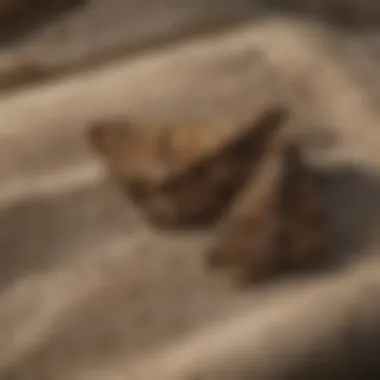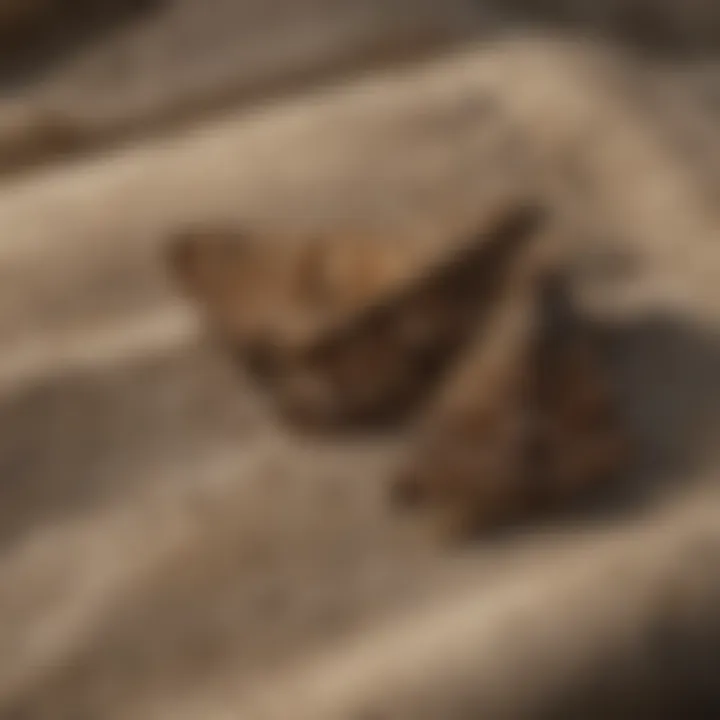Effective Strategies to Eliminate Small Moths in Bedrooms


Intro
Small moths in the bedroom can disrupt not only the aesthetics of the space but also the peace and comfort one desires during sleep. These tiny insects, often mistaken for harmless creatures, may indicate underlying issues with cleanliness or food storage. Understanding how to identify them, the reasons behind their presence, and effective methods for their removal is crucial for maintaining a serene sleeping environment. This article serves as a detailed guide, offering comprehensive strategies to tackle small moth infestations effectively, ensuring that your personal space remains a sanctuary.
Identifying Small Moths
Identifying the type of moth that has invaded your bedroom is the first step in elimination. Commonly, you might encounter species like the Indian Meal Moth, frequently found near food products, or the Clothes Moth, often attracted to fabrics. Here are key indicators to help with identification:
- Wings: Most moths have wings that are slender and long.
- Color: They might range from drab browns to vibrant hues. Keep an eye on metallic or iridescent shades.
- Habitat: Moths are often found fluttering around closets, pantries, or anywhere food is present.
- Larvae: Moth larvae are typically off-white with a dark head; using a flashlight can help locate them in dark corners.
Identifying the right type of moth can simplify the removal process significantly.
Preventive Measures
Once you've identified the moths, the focus shifts to prevention. The following practices can help eliminate their presence:
- Regular Cleaning: Maintain a routine that includes vacuuming bedrooms and closets. Pay attention to corners and baseboards.
- Food Storage: Store food in airtight containers to prevent access. Small moths are often attracted to grains and cereals.
- Fabric Care: Keep clothing, especially wool or silk, clean and stored properly. Regularly inspect seldom-used items.
- Lighting: Moths are attracted to light. Use yellow or sodium vapor lights outdoors to minimize attracting them.
Removal Techniques
If prevention fails and the infestation persists, implementing removal techniques becomes essential. Here are some practical approaches:
- Natural Remedies: Essential oils such as lavender, cedar, and peppermint can repel moths. Use them in sachets placed in closets or drawers.
- Pheromone Traps: These traps can lure and capture male moths, disrupting breeding cycles. Install these in various locations across the bedroom.
- Chemical Solutions: Utilize insect sprays that target moths specifically. Always follow the manufacturer's instructions for safe application.
- Professional Pest Control: If the infestation is severe, consider hiring a pest control expert who can provide specific treatments tailored to your situation.
Maintaining a Moth-Free Environment
After successfully eliminating the moths, maintaining a clean and organized environment is crucial. Continual vigilance can prevent future infestations. It is prudent to establish a regular cleaning schedule and inspect storage spaces periodically.
Implementing these strategies will enhance the overall comfort and cleanliness of your personal sanctuary, ensuring that small moths do not disrupt your peace. By embracing these methods, you can confidently enjoy a moth-free bedroom.
Understanding Small Moths
Understanding small moths is crucial for addressing infestations effectively. This section delineates the significance of comprehending their nature to empower individuals with the knowledge necessary for prevention and removal strategies. Small moths, often overlooked due to their relatively minor size, can create significant disruption in personal spaces. By recognizing their characteristics and behaviors, homeowners can take preemptive actions to mitigate the risk of infestations.
Species Overview
Several species of small moths are prevalent in domestic settings. Among the most common are the Indian meal moth, the clothes moth, and the pantry moth. Each of these species has unique traits and habits that dictate their presence in your home. The Indian meal moth, for example, is often found near stored grains and dried fruits, while the clothes moth targets fabrics. Understanding these species enables homeowners to identify potential sources of infestation and address them accordingly.
Physical Characteristics
Small moths generally range from a few millimeters to about one inch in length. Their bodies are slender and often exhibit muted colors such as gray or brown, which serves as camouflage. One distinctive feature of many small moths is their wings – often fringed or dusty in texture. The adult moths typically have a rounded head and long antennae. Knowing these physical traits can assist in quick identification, especially when assessing an infestation.
Behavior and Lifecycle
The behavior and lifecycle of small moths are integral to understanding their presence in your home. These moths begin their life cycle as eggs, laid in materials that serve as food sources for their larvae. The larvae stage is the most destructive phase, as they feed on fabrics, grains, and organic matter. Moths thrive in undisturbed areas where food sources are plentiful, making bedrooms and pantries ideal habitats. Understanding their lifecycle allows homeowners to implement strategies for breaking this cycle, thus mitigating future infestations.
"Recognizing the characteristics and behavior of small moths is key to effective prevention and control measures."
Overall, an in-depth understanding of small moths sets the foundation for effective pest management strategies. With knowledge comes the ability to act decisively against small moths and to maintain a serene living environment.
Identifying an Infestation
Identifying an infestation is a crucial step in controlling small moths in your bedroom. When you become aware of their presence early, you can take swift action to limit their population and prevent damage. Small moths, if left unchecked, can lead to destruction of fabrics, clothing, and stored food. Thus, this section focuses on the detailed clues and indicators that reveal their presence. Understanding these elements will help you establish a proactive approach to pest management.
Signs of Moth Presence


Recognizing the signs of small moths is essential for early intervention. Here are the most common indicators:
- Visible Adult Moths: Spotting moths flying around your bedroom is often the first sign of an infestation. They are typically small, with a wingspan of about half an inch.
- Larvae: Small caterpillars or larvae can often be found hidden in corners or near fabrics. They tend to have a distinctive appearance, usually whitish or creamy in color.
- Webbing and Casings: Adult moths create a webbing in areas where they breed and feed. You may find silken cases or webs near your clothing or in drawers, which indicate larvae activity.
- Damage to Fabrics: Check your clothing and bedding for any holes or frayed areas. This type of damage can often be traced back to moth larvae feeding.
Being vigilant about these signs will facilitate quicker action and reduce future risks.
Common Areas Affected
Small moths tend to favor certain locations within your environment. Common areas affected include:
- Closets: Dark, undisturbed areas in closets are prime spots for moth infestations. Fabrics left unchecked here can be quite vulnerable.
- Drawers: Clothing and bedding in drawers can attract moths, especially if items are not cleaned frequently.
- Pantry or Food Storage: Moths can also invade food storage areas, especially dry goods like grains and cereals. Small moths may contaminate your food.
- Behind Furniture: Forgotten spaces behind large pieces of furniture can harbour hidden moths.
By understanding where these pests are likely to nest, you can systematically inspect these targeted areas.
Distinguishing Moths from Other Pests
Identifying whether you have a moth problem or another pest issue is fundamental. Consider the following:
- Fly Behavior: Moths tend to fly erratically, especially when disturbed, while flies may have a more direct flight path.
- Physical Attributes: Adult moths have a more slender body and are covered in scales, unlike other household pests like flies or beetles, which can exhibit different body shapes.
- Feeding Habits: Moths typically feed on organic materials, while other pests may enjoy different types of food, suggesting distinct damage patterns. For example, ants may not damage fabrics at all.
Identifying the specific pest type can influence your clean-up and prevention strategies significantly. Pay attention to these details as they indicate the best course of action for effective removal.
Initial Response to an Infestation
An infestation of small moths in your bedroom can be distressing. Understanding how to respond initially is crucial for effective management. This phase can dictate your course of action, influencing the eventual success of your efforts. It is not just about dealing with the immediate problem but also about creating a systematic approach that minimizes future risks.
A swift reaction can prevent further infestation. Procrastinating or neglecting the issue may lead to more significant problems down the line. Moreover, understanding the severity of the infestation is essential. This insight helps you prioritize actions and decide whether a DIY approach is sufficient or if professional help is necessary.
Assessing the Severity
Assessing how severe the infestation is can take several methods. Look for visual cues in the bedroom, such as moths flying around or larvae in bedding and fabric. Note if you see moths during the daytime or mainly at night. Daytime activity can indicate a more significant issue.
Take into account the lifespan and breeding rate of the species you've encountered. Some moths can reproduce quickly, intensifying the problem as time progresses. It is vital to determine whether you see only a few moths or a larger population. If you see webbing or cocoons, this is a sign of an established presence that requires urgent attention.
Include the following in your assessment:
- Location: Where are you noticing moth activity?
- Count: How many moths do you see?
- Damage: Are there any destroyed fabrics or other signs of feeding?
Understanding these factors helps create an effective plan for removal.
Gathering Necessary Materials
After assessing the situation, it's time to gather necessary materials. Having the right tools can make the removal process more efficient. You will need items tailored to address the identified problems. Here are some essentials to consider:
- Vacuum Cleaner: A strong vacuum can capture both adult moths and larvae quickly.
- Sticky Traps: These traps can help monitor the severity and effectiveness of your removal actions.
- Hot Water and Detergent: Washing affected fabrics in hot water with a bit of detergent can kill eggs and larvae.
- Natural Repellents (e.g., cedar, lavender): These can be used in storage areas and wardrobes to deter moths.
- Trash Bags: Store and dispose of contaminated items responsibly to prevent re-infestation.
Having these materials at hand will facilitate a systematic and secure approach to your initial response, helping to restore comfort and safety in your bedroom.
Effective Removal Techniques
Effective removal techniques are vital in addressing small moth infestations in your bedroom. These methods not only eliminate the immediate presence of moths but also help prevent future occurrences. By using a combination of these techniques, you ensure a thorough approach to pest control, thus maintaining a comfortable and serene sleeping environment.
Vacuuming Methods
Vacuuming serves as one of the most efficient ways to remove moths and their larvae from your bedroom. A powerful vacuum can physically extract these pests from carpets, upholstery, and other surfaces where they may hide. It is important to focus on corners, crevices, and other hard-to-reach areas, as these often become breeding grounds. Use an attachment for upholstery to enhance your reach and effectiveness.


After vacuuming, you should immediately dispose of the vacuum bag or empty the dust container outdoors. This helps to prevent any remaining moths from re-entering your living space. Regular vacuuming not only addresses an existing issue but also acts as a preventive measure against future infestations. 🐛
Washing Bedding and Fabrics
Washing all bedding and fabrics within the bedroom is crucial following any signs of moth activity. This includes sheets, comforters, pillowcases, and even curtains. Use hot water whenever possible, as higher temperatures effectively kill any present moths and larvae.
For delicate items, opt for dry cleaning, which can also be an effective solution. Frequent washing will disrupt the life cycle of moths and hinder any potential infestations. Ensure that you pay attention to laundry baskets and storage areas where fabrics are kept; clean these surfaces regularly to maintain a moth-free environment.
Utilizing Traps and Baits
Setting up traps and baits can significantly aid in controlling small moth populations. Pheromone traps attract male moths, which disrupts their breeding cycle. These traps can be easily placed in various locations within your bedroom. Be sure to follow the product instructions for optimal positioning and maintenance.
Bait stations can also be effective. These often contain substances that attract moths, combined with insecticides that eliminate them upon contact. Combining traps and baits with other removal techniques increases their efficacy. This method is particularly useful for monitoring ongoing problems and ensuring that new moths do not become established.
Insecticides and Natural Solutions
Insecticides can provide immediate relief from moth infestations. Look for products specifically designed for moths. Read and follow the instructions to make sure you apply them safely and effectively. Focus on cracks and corners where moths may hide or breed.
Alternatively, consider natural solutions such as essential oils. For instance, lavender and cedar oil are known to repel moths effectively. You can dilute these oils with water and spray them around the infested areas. This approach not only avoids chemical exposure but also leaves a pleasant scent.
Implementing a combination of insecticides and natural methods often yields the best results when dealing with small moth infestations.
Preventive Measures
Preventive measures are essential in avoiding small moth infestations in your bedroom. Maintaining a clean and well-organized environment can significantly reduce the likelihood of these pests taking residence in your personal space. Most infestations occur when moths find food sources or suitable breeding grounds in close proximity to living areas, making proactive steps necessary to keep them at bay. By focusing on specific elements such as cleaning, storage, and repellents, homeowners can ensure their bedrooms remain comfortable sanctuaries free from these nuisances.
Regular Cleaning Practices
Regular cleaning is the backbone of any effective strategy against moths. Routine vacuuming can eliminate potential eggs and larvae, reducing their chance of developing into adult moths. Pay special attention to carpets, corners, and under furniture, as these areas can often be neglected.
It's advisable to wash bedding at least once a week in hot water. Doing so not only removes dust but also destroys any moth eggs that may have been laid. Additionally, curtains, upholstered furniture, and linens should be cleaned frequently.
- Remove Clutter: De-cluttering can limit hiding spots for moths. Organize your space to minimize areas where moths can thrive.
- Use a Damp Cloth: Wipe down surfaces regularly to remove food particles and dust that could attract pests.
- Dispose of Old Items: Regularly review items such as clothes, books, or newspapers that may not be needed and dispose of them appropriately.
Proper Storage Techniques
Proper storage techniques play a vital role in moth prevention. Moths are attracted to natural fibers, so carefully managing how clothes and fabrics are stored is crucial.
Use airtight containers to store wool, cashmere, and other natural fabrics. This limits access for moths and prevents them from laying eggs in your stored possessions. When using storage bags, ensure they are breathable, allowing for air circulation while still deterring moth entry.
- Seasonal Rotation: Rotate seasonal clothing to minimize storage time for items. This prevents moths from creating a stable habitat in seldom-used garments.
- Label Containers: Clearly label storage containers to avoid unnecessary opening of bags that could disturb any potential moth presence.
- Keep Inventory: Maintain an inventory of stored items to know exactly what and where they are, reducing the likelihood of old clothes sitting unattended for long periods.
Using Moth Repellents
Moth repellents can be effective tools in your pest control arsenal. Using natural or chemical repellents can deter moths from settling in your bedroom. Natural options like cedar chips and lavender sachets are popular among homeowners. They provide a pleasant fragrance while offering repellant properties that can effectively keep moths away.
Chemical treatments may also be necessary for significant infestations. Look for products specifically designed to target moths, and always follow the instructions for safe application.
- Regular Replacement: If using natural repellents, such as herbs or essential oils, ensure they are regularly replaced to maintain effectiveness.
- Strategic Placement: Place repellents in known problem areas, like closets and drawers, where moth activity is suspected.
- Read Labels: Always check product labels for safety information, especially in areas where children or pets are present.
Keeping moths away requires consistent and proactive measures. A clean, organized space, combined with effective storage and the right repellents, can create a protective barrier against moth infestations.
Reinforcement of Environmental Control
Reinforcing environmental control within your bedroom is crucial in the battle against small moth infestations. This approach focuses on altering the surroundings to make them less conducive for moths to breed and thrive. Implementing effective environmental control measures can greatly reduce the risk of moths infesting your living space. Understanding how humidity and temperature, as well as light exposure, can attract or repel these pests is essential in achieving a moth-free environment.


Humidity and Temperature Management
Humidity and temperature play a significant role in the lifecycle of small moths. Moths prefer warm, humid conditions as these factors accelerate their reproduction. Maintaining lower humidity levels in your bedroom can make it less inviting for moths to settle.
- Use Dehumidifiers: Consider using a dehumidifier to help reduce moisture in the air. Keeping the humidity around 30-50% makes the environment less appealing to moths.
- Ventilation: Ensure good airflow either by opening windows when the weather permits or using fans. This can help maintain a more balanced humidity level indoors.
- Temperature Control: Moths are attracted to warmth. Keeping the temperature cool not only discourages moths but also improves your sleep comfort.
Light and Attraction Adjustments
Light sources are often overlooked aspects of pest control. Small moths are drawn to light, especially at night. Adjusting your lighting can therefore play a vital role in keeping these pests away.
- Choose Warm Yellow Lights: Consider replacing bright white fixtures with warmer yellow light bulbs. These tend to attract fewer moths.
- Outdoor Light Management: If you notice moths around entry points, evaluate the outdoor lighting. Reducing the brightness of outside lights or installing motion-activated lights can decrease attractants.
- Keep Windows Covered: During the evening, ensure windows are covered with curtains or blinds to limit light exposure that can attract moths.
Managing environmental factors like humidity, temperature, and light will not only help in reducing small moths but will also enhance the overall comfort of your living space.
By implementing these reinforcement measures, you create a less appealing environment for small moths. This proactive approach not only aids in keeping your bedroom clean but also contributes to your peace of mind and comfort. Regularly reassessing these conditions is key to maintaining a long-term solution against infestations.
When to Seek Professional Help
It is crucial to recognize that DIY methods for dealing with small moth infestations may not always lead to complete resolution. In some cases, the infestation can grow beyond what household remedies can manage. Understanding when to seek professional help is vital for maintaining a healthy living environment. Not only can experts identify the specific type of moth, but they can also offer tailored solutions and treatments that are more potent than over-the-counter options. The benefits of hiring professionals include saving time, ensuring safety during treatment, and providing a long-term control plan.
In summary, professional exterminators can diagnose the issue effectively and create a strategy that addresses the root cause and prevention, reducing the likelihood of a future infestation.
Maintaining a Moth-Free Environment
Maintaining a moth-free environment is crucial in ensuring the comfort and cleanliness of your sleeping space. Small moths can quickly turn a serene bedroom into a troublesome area if not addressed promptly. By understanding the elements that contribute to a pest-free environment, one can take actionable steps to minimize the risk of infestation. Regular monitoring and effective preventive measures not only protect your belongings but also create a more pleasant living situation.
Continuous Monitoring Techniques
Continuous monitoring techniques play a vital role in maintaining a moth-free bedroom. This involves regularly checking for signs of moth activity and promptly addressing any issues that arise. You can adopt several strategies to keep track of the potential presence of small moths:
- Visual Inspections: Conduct routine checks around your bedroom, including closets and storage areas. Look for any adult moths, larvae, or webbing that may indicate an infestation.
- Adhesive Traps: Place sticky traps in various corners and hotspots of your bedroom. These traps can catch flying adult moths, giving you an early warning of any problems.
- Seasonal Assessments: Be particularly vigilant during warmer months when moth activity tends to increase. Review your cleaning routines to ensure they are up to date.
Adopting a consistent monitoring approach significantly increases the chance of detecting small moths early, allowing for timely intervention.
Reassessing Preventive Methods
Reassessing preventive methods is essential in the ongoing battle against small moths. What might have worked one season may not be as effective in another. Evaluating your strategies regularly ensures adaptability to changing conditions and keeps moths at bay. Consider the following:
- Storage Solutions: Review how you store your clothes and textiles. Using airtight containers can effectively prevent moth access. Make sure to regularly inspect items that are stored away for long periods, as they can become unattended nests.
- Pest Repellents: Consider changing or adding new repellents to your routine. Some natural options include lavender sachets and cedar blocks, which not only repel moths but also impart a pleasant fragrance in your space.
- Cleaning Frequency: Adjust your cleaning schedule according to moth activity. If you've noticed an increase in moths, enhancing your cleaning practices to include more frequent vacuuming, especially in hidden areas can make a difference.
End
The conclusion of this article emphasizes the critical aspects of dealing with small moth infestations in bedroom spaces. Understanding the full scope of the problem is not just about immediate removal but also about creating a lasting strategy for a moth-free environment.
The importance of maintaining a clean and organized bedroom cannot be overstated. By implementing regular cleaning practices and proper storage techniques, homeowners can significantly reduce the likelihood of an infestation happening in the first place. Each small step taken in this regard contributes to a larger picture of prevention and control. This consistency is what transforms a temporary fix into a proactive approach.
Furthermore, the discussion on when to seek professional help highlights that some infestations may exceed the capabilities of self-removal methods. Recognizing these situations ensures that the problem can be addressed comprehensively and efficiently, preserving the sanctity of one’s personal space.
In summary, effective management of small moth presence involves three pivotal components: thorough identification, effective removal techniques, and steadfast preventive measures. Homeowners who grasp these elements not only enhance their sleeping environment but also uplift their overall well-being by creating more serene and peaceful living spaces.
Summary of Key Points
- Identifying small moths promptly is the first step in addressing an infestation.
- Immediate removal techniques include vacuuming, washing fabrics, and possibly using traps.
- Prevention is key: Regular cleaning and appropriate storage practices play an essential role in keeping moths at bay.
- Environmental control, including managing humidity and light, helps to reduce attraction to these pests.
- Professional help should be sought if the infestation is overwhelming or persistent, ensuring long-term resolution.
Encouragement for Consistent Practices
It is essential to normalize effective practices in household management to keep moths and other pests at bay. Consistency is crucial. Establish a cleaning routine that involves thorough checks of your storage spaces—including closets and drawers—to catch any possible issues early.
Consider using natural repellents to deter moths and regularly assessing your environment for signs of pest activity. The routine you create will serve not only to combat small moths but will also enhance your living space overall.
By instilling these habits, you are not just eliminating a nuisance but also contributing to a more harmonious and pleasant home environment. Make the commitment to engage in these practices regularly, and enjoy the peace of mind that comes with a moth-free bedroom.















